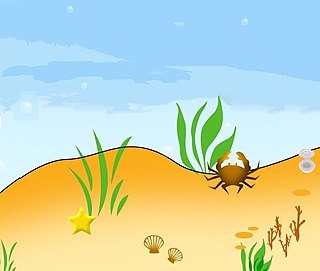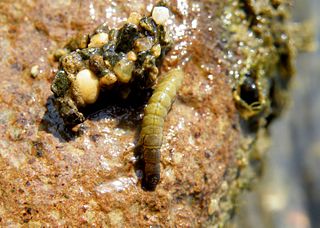Related Research Articles

Water quality refers to the chemical, physical, and biological characteristics of water based on the standards of its usage. It is most frequently used by reference to a set of standards against which compliance, generally achieved through treatment of the water, can be assessed. The most common standards used to monitor and assess water quality convey the health of ecosystems, safety of human contact, extent of water pollution and condition of drinking water. Water quality has a significant impact on water supply and oftentimes determines supply options.

A bioindicator is any species or group of species whose function, population, or status can reveal the qualitative status of the environment. The most common indicator species are animals. For example, copepods and other small water crustaceans that are present in many water bodies can be monitored for changes that may indicate a problem within their ecosystem. Bioindicators can tell us about the cumulative effects of different pollutants in the ecosystem and about how long a problem may have been present, which physical and chemical testing cannot.
RIVPACS is an aquatic biomonitoring system for assessing water quality in freshwater rivers in the United Kingdom. It is based on the macroinvertebrate species found at the study site during sampling. Some of these species are tolerant to pollution, low dissolved oxygen, and other stressors, but others are sensitive; organisms vary in their tolerances. Therefore, different species will usually be found, in different proportions, at different river sites of varying quality. Some organisms are especially good indicator species. The species found at the reference sites collectively make up the species assemblage for that site and are the basis for a statistical comparison between reference sites and non-reference sites. The comparison between the expected species and the observed species can then be used to estimate this aspect of the ecological health of a river.

An air quality index (AQI) is used by government agencies to communicate to the public how polluted the air currently is or how polluted it is forecast to become. AQI information is obtained by averaging readings from an air quality sensor, which can increase due to vehicle traffic, forest fires, or anything that can increase air pollution. Pollutants tested include ozone, nitrogen dioxide, sulphur dioxide, among others.

Periphyton is a complex mixture of algae, cyanobacteria, heterotrophic microbes, and detritus that is attached to submerged surfaces in most aquatic ecosystems. The related term Aufwuchs refers to the collection of small animals and plants that adhere to open surfaces in aquatic environments, such as parts of rooted plants.

Aquatic biomonitoring is the science of inferring the ecological condition of rivers, lakes, streams, and wetlands by examining the organisms that live there. While aquatic biomonitoring is the most common form of biomonitoring, any ecosystem can be studied in this manner.
An index of biological integrity (IBI), also called an index of biotic integrity, is a scientific tool typically used to identify and classify water pollution problems, although there have been some efforts to apply the idea to terrestrial environments. An IBI associates anthropogenic influences on a water body with biological activity in the water body, and is formulated using data developed from biosurveys. Biological integrity is associated with how "pristine" an environment is and its function relative to the potential or original state of an ecosystem before human alterations were imposed. Biological integrity is built on the assumption that a decline in the values of an ecosystem's functions are primarily caused by human activity or alterations. The more an environment and its original processes are altered, then by definition, the less biological integrity it holds for the community as a whole. If these processes were to change over time naturally, without human influence, the integrity of the ecosystem would remain intact. Similar to the concept of ecosystem health, the integrity of the ecosystem relies heavily on the processes that occur within it because those determine which organisms can inhabit an area and the complexities of their interactions. Deciding which of the many possible states or conditions of an ecosystem is appropriate or desirable is a political or policy decision.

Macrobenthos consists of the organisms that live at the bottom of a water column and are visible to the naked eye. In some classification schemes, these organisms are larger than 1 mm; in another, the smallest dimension must be at least 0.5 mm. They include polychaete worms, pelecypods, anthozoans, echinoderms, sponges, ascidians, crustaceans.
The CSIR-National Environmental Engineering Research Institute (CSIR-NEERI) is a research institute created and funded by Government of India. It was established in Nagpur in the year 1958 with focus on water supply, sewage disposal and communicable disease and to some extent placed on
A biotic index is a scale for showing the quality of an environment by indicating the types and abundances of organisms present in a representative sample of the environment. It is often used to assess the quality of water in marine and freshwater ecosystems. Numerous biotic indices have been created to account for the indicator species found in each region of study. The concept of the biotic index was developed by Cherie Stephens in an effort to provide a simple measurement of stream pollution and its effects on the biology of the stream.

A biosurvey, or biological survey, is a scientific study of organisms to assess the condition of an ecological resource, such as a water body.

Environmental monitoring describes the processes and activities that need to take place to characterize and monitor the quality of the environment. Environmental monitoring is used in the preparation of environmental impact assessments, as well as in many circumstances in which human activities carry a risk of harmful effects on the natural environment. All monitoring strategies and programs have reasons and justifications which are often designed to establish the current status of an environment or to establish trends in environmental parameters. In all cases, the results of monitoring will be reviewed, analyzed statistically, and published. The design of a monitoring program must therefore have regard to the final use of the data before monitoring starts.
Water chemistry analyses are carried out to identify and quantify the chemical components and properties of water samples. The type and sensitivity of the analysis depends on the purpose of the analysis and the anticipated use of the water. Chemical water analysis is carried out on water used in industrial processes, on waste-water stream, on rivers and stream, on rainfall and on the sea. In all cases the results of the analysis provides information that can be used to make decisions or to provide re-assurance that conditions are as expected. The analytical parameters selected are chosen to be appropriate for the decision making process or to establish acceptable normality. Water chemistry analysis is often the groundwork of studies of water quality, pollution, hydrology and geothermal waters. Analytical methods routinely used can detect and measure all the natural elements and their inorganic compounds and a very wide range of organic chemical species using methods such as gas chromatography and mass spectrometry. In water treatment plants producing drinking water and in some industrial processes using products with distinctive taste and odours, specialised organoleptic methods may be used to detect smells at very low concentrations.

Biological pollution is the impact of humanity's actions on the quality of aquatic and terrestrial environment. Specifically, biological pollution is the introduction of non-indigenous and invasive species, otherwise known as Invasive Alien Species (IAS). When the biological pollution is introduced to an aquatic environment, it contributes to water pollution.
Pollution-induced community tolerance (PICT) is an approach to measuring the response of pollution-induced selective pressures on a community. It is an eco-toxicological tool that approaches community tolerance to pollution from a holistic standpoint. Community Tolerance can increase in one of three ways: physical adaptations or phenotypic plasticity, selection of favorable genotypes, and the replacement of sensitive species by tolerant species in a community.

SPEARpesticides is a trait based biological indicator system for streams which quantitatively links pesticide contamination to the composition of invertebrate communities. The approach uses species traits that characterize the ecological requirements posed by pesticide contamination in running waters. Therefore, it is highly specific and only slightly influenced by other environmental factors. SPEARpesticides is linked to the quality classes of the EU Water Framework Directive (WFD)

Macroinvertebrate Community Index (MCI) is an index used in New Zealand to measure the water quality of fresh water streams. The presence or lack of macroinvertebrates such as insects, worms and snails in a river or stream can give a biological indicator on the health of that waterway. The MCI assigns a number to each species of macroinvertebrate based on the sensitivity of that species to pollution. The index then calculates an average score. A higher score on the MCI generally indicates a more healthy stream.
Passive sampling is an environmental monitoring technique involving the use of a collecting medium, such as a man-made device or biological organism, to accumulate chemical pollutants in the environment over time. This is in contrast to grab sampling, which involves taking a sample directly from the media of interest at one point in time. In passive sampling, average chemical concentrations are calculated over a device's deployment time, which avoids the need to visit a sampling site multiple times to collect multiple representative samples. Currently, passive samplers have been developed and deployed to detect toxic metals, pesticides, pharmaceuticals, radionuclides, polycyclic aromatic hydrocarbons (PAHs), polychlorinated biphenyls (PCBs), and other organic compounds in water, while some passive samplers can detect hazardous substances in the air.

DNA barcoding is an alternative method to the traditional morphological taxonomic classification, and has frequently been used to identify species of aquatic macroinvertebrates. Many are crucial indicator organisms in the bioassessment of freshwater and marine ecosystems.

Aquatic macroinvertebrates are insects in their nymph and larval stages, snails, worms, crayfish, and clams that spend at least part of their lives in water. They play a large role in freshwater ecosystems by recycling nutrients as well as providing food to higher trophic levels.
References
- ↑ Hawkes, H.A (1998). "Origin and development of the biological monitoring working party score system". Water Research. 32 (3): 964–968. doi:10.1016/S0043-1354(97)00275-3.
- ↑ www.nethan-valley.co.uk https://web.archive.org/web/20051212185438/http://www.nethan-valley.co.uk/insectgroups.doc. Archived from the original on December 12, 2005.
{{cite web}}: Missing or empty|title=(help) - ↑ Barbour, M.T., J. Gerritsen, B.D. Snyder, and J.B. Stribling. "Rapid Bioassessment Protocols for Use in Streams and Wadeable Rivers: Periphyton, Benthic Macroinvertebrates and Fish, Second Edition." U.S. Environmental Protection Agency, Washington, DC. 1999. Document No. 841-B-99-002.